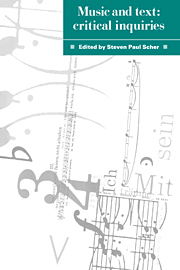Book contents
- Frontmatter
- Contents
- List of figures
- List of contributors
- Preface
- Acknowledgments
- Part I Institutional dimensions and the contexts of listening
- 1 Music and literature: the institutional dimensions
- 2 Privileging the moment of reception: music and radio in South Africa
- 3 Chord and discourse: listening through the written word
- Part II Literary models for musical understanding: music, lyric, narrative, and metaphor
- Part III Representation, analysis, and semiotics
- Part IV Gender and convention
- Index
1 - Music and literature: the institutional dimensions
Published online by Cambridge University Press: 04 September 2009
- Frontmatter
- Contents
- List of figures
- List of contributors
- Preface
- Acknowledgments
- Part I Institutional dimensions and the contexts of listening
- 1 Music and literature: the institutional dimensions
- 2 Privileging the moment of reception: music and radio in South Africa
- 3 Chord and discourse: listening through the written word
- Part II Literary models for musical understanding: music, lyric, narrative, and metaphor
- Part III Representation, analysis, and semiotics
- Part IV Gender and convention
- Index
Summary
Comparative studies may look at the contacts, overlappings, and interactions between fields, or they may consider general analogies and contrasts between them. The former undoubtedly provide a sounder base and surer methodology than general comparisons, which are often arbitrary in their choices and vague in their conclusions. But interactions and overlappings usually occur at the disciplinary margins, which tend to appear indeed marginal to those who work in the respective fields.
Like most comparatists, I question the epistemological value of disciplinary boundaries, but, as my very title indicates, I recognize that we live in institutions whose divisional boundaries, however arbitrary, are difficult to overcome. Genuinely successful interdisciplinary studies of a “margin” will have to convince the scholars at the center that questions at the margin are actually central to their field. Such studies should foster then a perspectival shift of what is important in a field, a reinterpretation of what is center and what is margin.
Within mixed genres, like opera and the Lied, the music is more often part of the canonical musical repertoire than the text of the canonized literature. Though dual genres are both legitimate and important as subjects of comparative studies, they usually yield specialized results which do not lend themselves to the kind of generalized conclusions that are necessary to combat professional parochialism. If we are to convince our colleagues that the joint study of music and literature is important, we must demonstrate that our conclusions affect what they do.
- Type
- Chapter
- Information
- Music and TextCritical Inquiries, pp. 3 - 20Publisher: Cambridge University PressPrint publication year: 1992
- 1
- Cited by

